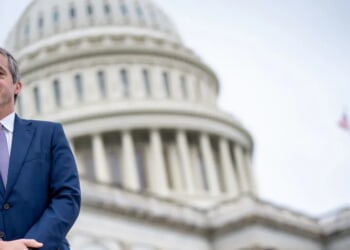Business investment surged in the wake of Donald Trump’s re-election.
This “capex comeback” shouldn’t have come as a surprise. Trump’s election alongside a Republican Congress meant the previous administration’s failed tax-and-spend policies would soon be replaced by policies similar to those that helped the economy thrive during the first Trump term. The magnitude of the capex comeback is enormous.
As Treasury Secretary Scott Bessent recently highlighted, “Business equipment production jumped 11% (annualized) in Q2, following a massive 23% gain in Q1 — the strongest non-pandemic back-to-back growth since 1997.” (For the math-challenged among us, 1997 is nearly 30 years ago!)
Indeed, capex — what businesses spend on purchasing, maintaining, or upgrading their fixed assets, including buildings, machinery, and vehicles — is up 16.6% in the first half of 2025. This didn’t happen by accident. (RELATED: Majority Of Small Business Owners Are Optimistic About Trump Policies, Survey Says)
Why the sudden turnaround?
In short, the future isn’t what it once was. It’s better. Allow me to explain.
It would be a severe understatement to say Kamala Harris and Donald Trump offered voters different visions of the future, based on wholly divergent policies and priorities. Perhaps never before has the contrast in a presidential election been starker.
Harris offered a continuation of the Biden administration’s endless addiction to regulation, taxes, and federal spending. Paraphrasing President Ronald Reagan, Harris’ “view of the economy could be summed up in a few short phrases: If it moves, tax it. If it keeps moving, regulate it. And if it stops moving, subsidize it.”
Trump, meanwhile, emphasized less regulation, lower taxes, and less federal spending. (Drain the swamp!) With Trump’s win, the outlook for economic growth and investment opportunity changed dramatically for the better. Businesses responded by investing heavily in a future that did not exist prior to his re-election.
Consider the following:
Regulation
• According to the American Action Forum (AAF): “[T]he cumulative total of regulatory costs under the Biden Administration added up to more than $1.8 trillion — far exceeding any preceding administration on record.” Harris promised more of the same.
• By contrast, President Trump’s Executive Order 14192, signed day one of his second administration, mandates eliminating 10 existing federal regulations for each new regulation. AAF estimates that the Trump administration has, to date, reduced the regulatory burden by $86 billion. And Trump has only begun.
• Deregulation leads to more growth.
Taxes
• President Biden’s budgets routinely proposed massive tax increases. His final budget, for example, included a $4.9 trillion tax increase. That’s telling, considering that Harris, when asked if she would have done anything differently than President Biden, replied, “[N]ot a thing comes to mind.”
• President Trump campaigned on blocking a $4 trillion tax hike that was scheduled to occur next year. Not only did Trump successfully block the tax increase, but he also signed tax provisions into law to spur investment in tools, machinery, structures, and cutting-edge research and development.
• Pro-growth tax policy leads to more growth.
Federal Spending
• President Biden’s budgets routinely proposed massive spending increases. His final budget, for example, included a $1.7 trillion spending increase. Apparently, the $84.931 trillion that the federal government was then projected to spend over fiscal years 2025-34 was insufficient, proving that Biden never saw a dollar he didn’t want to spend. Harris promised more of the same.
• The Trump administration has yet to submit its full budget for fiscal year 2026, but the “skinny budget” it issued calls upon Congress to slash non-defense discretionary spending by 22.6%. It’s doubtful Congress will adopt cuts of that magnitude, but the administration is making progress, having unleashed the Department of Government Efficiency (DOGE) to produce an estimated $190 billion in savings thus far. That’s $190 billion extracted from the public sector and returned to the private sector.
• Extracting fewer resources from the private sector generally leads to more growth.
Business investment is typically the most volatile element of gross domestic product, but the capex comeback is very real. And it’s happening because the Trump administration, with Congress’ help, is putting into place economic policies that will ignite American growth and prosperity.
James Carter is a Principal with Navigators Global. He previously headed President-elect Donald Trump’s tax team during the 2016-17 transition and served as a Deputy Assistant Secretary of the Treasury for President George W. Bush.
The views and opinions expressed in this commentary are those of the author and do not reflect the official position of the Daily Caller News Foundation.
All content created by the Daily Caller News Foundation, an independent and nonpartisan newswire service, is available without charge to any legitimate news publisher that can provide a large audience. All republished articles must include our logo, our reporter’s byline and their DCNF affiliation. For any questions about our guidelines or partnering with us, please contact licensing@dailycallernewsfoundation.org.



![Former Bravo Star Charged After Violent Assault Using a Rock-Filled Sock in Tennessee Walmart [WATCH]](https://www.right2024.com/wp-content/uploads/2025/07/Former-Bravo-Star-Charged-After-Violent-Assault-Using-a-Rock-Filled-350x250.jpg)



![Illegal Alien Walked Free After Decapitating Woman, Abusing Corpse for Weeks [WATCH]](https://www.right2024.com/wp-content/uploads/2025/07/1753013138_Illegal-Alien-Walked-Free-After-Decapitating-Woman-Abusing-Corpse-for-350x250.jpg)
![NYC Man Snatches Child Off The Sidewalk, Parents Chase Him Down [WATCH]](https://www.right2024.com/wp-content/uploads/2025/07/NYC-Man-Snatches-Child-Off-The-Sidewalk-Parents-Chase-Him-350x250.jpg)
![Karoline Leavitt Levels CNN's Kaitlan Collins and Other Legacy Media Reporters [WATCH]](https://www.right2024.com/wp-content/uploads/2025/07/Karoline-Leavitt-Levels-CNNs-Kaitlan-Collins-and-Other-Legacy-Media-350x250.jpg)
![Man Arrested After Screaming at Senators During Big Beautiful Bill Debate [WATCH]](https://www.right2024.com/wp-content/uploads/2025/06/Man-Arrested-After-Screaming-at-Senators-During-Big-Beautiful-Bill-350x250.jpg)
![Leftists Lose Their Minds After Jason Kelce Celebrates Being an American [WATCH]](https://www.right2024.com/wp-content/uploads/2025/07/Leftists-Lose-Their-Minds-After-Jason-Kelce-Celebrates-Being-an-350x250.jpg)





